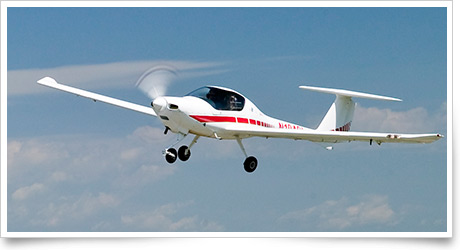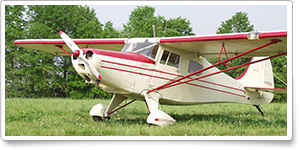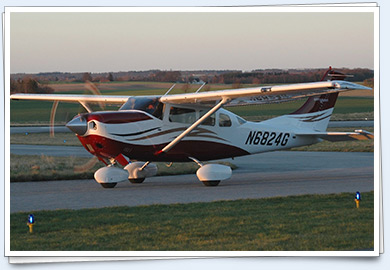Aug. 31, 2012, issue of 'AOPA ePilot: Flight Training Edition' weekly newsletter
| ||||||
| Departing the pattern |
| |||||
Training TipsDeparting the pattern
What comes next?
Before you exit the airport area, there is still a departure to fly. It also demands exact technique.
Ask many pilots to identify the legs of an airport traffic pattern. You will most often hear five named: upwind, crosswind, downwind, base, and final legs.
There's a sixth, with its own recommended altitudes and procedures: the departure leg. Fly it properly to add predictability and safety to operations near the airport.
The departure leg is described in the Aeronautical Information Manual as “the flight path which begins after takeoff and continues straight ahead along the extended runway centerline.” The departure climb is one that “continues until reaching a point at least a half mile beyond the departure end of the runway and within 300 feet of the traffic pattern altitude.”
If you are exiting the airport area (not remaining in the traffic pattern to practice takeoffs and landings), “continue straight out, or exit with a 45-degree turn (to the left when in a left-hand traffic pattern; to the right when in a right-hand traffic pattern) beyond the departure end of the runway, after reaching pattern altitude,” says Chapter 13 of the Pilot’s Handbook of Aeronautical Knowledge.
Competent communications complement correct comings and goings, so when departing a nontowered airport, be sure that you include a statement of your intentions in a concise announcement on the common traffic advisory frequency (CTAF).
Departing from an airport with a control tower, the scenario may differ, especially if it also has radar service. For example you might be issued instructions to “maintain runway heading,” or to turn to an assigned heading when able after takeoff. In a subsequent radio call the tower controller (or a radar departure controller, after you are “handed off” to that facility) may issue new instructions, or direct you to proceed on course.
Those instructions are issued for sequencing traffic, or to get you on course in the most orderly manner possible. In either case, but be sure to acknowledge the instructions, and remember to avoid unexpected maneuvers in the traffic pattern—only one of which can disrupt an orderly flow of arrivals and departures at a bustling airport. Flight Training NewsNation mourns ArmstrongApollo 11 Commander Neil Armstrong, whose “small step” marked mankind’s first visit to the moon, died Aug. 25 of complications following a cardiovascular procedure. He was 82. Armstrong took control of the first manned lunar landing on July 20, 1969, in the lunar module Eagle. Read more >> Chat with the ‘Flight Training’ editorsYou’ve got your sport pilot or private pilot certificate—but now what? Are you running out of ideas after taking your friends aloft? Come chat with Flight Training Editor Ian Twombly and Technical Editor Jill Tallman on Wednesday, Sept. 5, at 3 p.m. Eastern time. Our guest chatter will be Flight Training Contributing Editor Greg Brown, author of the monthly column “Flying Carpet.” One chat participant will receive an autographed copy of Brown’s book, Flying Carpet: The Soul of an Airplane. Log on to the chat or sign up for an email reminder. Texas FBO breaks ground on new facilityAnson Aviation at Sugar Land Regional Airport in Houston, Texas, has broken ground on a new 24,000-square-foot office and hangar facility. When completed, the new building will feature individual briefing rooms, FAA knowledge testing capability, classrooms, and a dedicated flight planning room. The $3 million facility also will create 15 new jobs, a company spokesman said. UAS, the NAS, and youDo the words “unmanned aircraft systems (UAS)” spike your interest? Then jump on board with the Air Safety Institute’s latest online course, Unmanned Aircraft and the National Airspace System , developed in collaboration with the Department of Defense. Get the scoop directly from the source: UAS military training operations are expected to increase dramatically by 2015, and unfettered National Airspace System access—as opposed to expanding special-use airspace—would allow military UAS pilots to train and stay proficient. Curious about the implications for GA? Explore how manned and unmanned aircraft can safely share the same airspace. Pilot receives probation for falsified logbookAn Iowa pilot who pleaded guilty to falsifying his logbook so that he could enroll in training for a commercial certificate received four years’ probation. According to the Associated Press, attorneys for Fahad Nabeel Hussein Al-Daous of Waterloo, Iowa, argued that the stay-at-home father lied about his flight hours to save money on getting the certificate. Prosecutors said he posed a public safety risk because his falsified hours would have permitted him to get advanced certificates without adequate flight experience. Al-Daous was sentenced on Aug. 22. Training ResourcesLearning the intricacies of today’s airspace is a big task and a necessary one for every pilot. But the Air Safety Institute has everything you need to make sense of it all. In one place, you’ll find everything you need to know about the various types of airspace, their communication requirements, weather minimums, and more. From the downloadable Airspace Flash Cards to the Know Before You Go online course, the Airspace Safety Spotlight is your one-stop education destination before you even leave the ground.
Did you know that student pilots who join AOPA are three times more likely to complete their flight training? Membership includes unlimited access to aviation information by phone (800/USA-AOPA, weekdays from 8:30 a.m. to 6 p.m. Eastern time) or from Flight Training Online or AOPA Online. If you’re not already a member, join today and get the pilot’s edge. Login information is available online. AOPA Live This Week: Inside the Republican National ConventionAOPA Live takes you inside the Republican National Convention and gets Mitt Romney’s answers on user fees. Plus, review AOPA’s new FlyQ Pocket Android app, fly the Velocity V-Twin, and watch a tribute to the late Neil Armstrong. All this and more on AOPA Live This Week, Aug. 30. Aviation high school Career PilotAmerican continues push to void pilot contractAMR Corp., the parent company of American Airlines that is in Chapter 11 bankruptcy reorganization, petitioned the bankruptcy court Aug. 17 to void its collective bargaining agreement with its pilots’ union, the Allied Pilots Association. The move came only two days after U.S. Bankruptcy Judge Sean Lane rejected an earlier proposal because neither American’s business plan nor its competitor’s practices justified the carrier’s request to furlough 450 pilots and increase code sharing with other carriers, the Dallas Morning News reported. The court has scheduled a hearing Sept. 4 on the carrier’s revised petition. Antitrust concerns raised over US Airways/American mergerA 28-page white paper sent to the U.S. Department of Justice by the American Antitrust Institute and the Business Travel Coalition outlined their opposition to a potential merger of US Airways and American Airlines, AIN Online reported Aug. 13. The organizations said the merger would create the largest U.S. carrier, controlling more than 20 percent of the market, and “could substantially reduce competition on a number of routes, create regional strongholds at key airports across the country, and starve smaller communities of air service vital to their business interests.” Plane SpotterTaylorcraft: Taildragger built for two Training ProductsFat Gecko Co-Pilot video camera mountIf you are using a video camera to record your lessons, where do you mount it inside the airplane? The Fat Gecko Co-Pilot mount works in an aircraft that has two windows that face each other. When placed in the cockpit, the mount can suspend a video camera in the rear of the airplane looking between the seats. Once attached, the camera can be adjusted to shoot up or down, turned sideways, or reversed. The mount supports cameras up to five pounds. It sells for $74.99 at PilotMall.com. Order online or call 800/249-5730. Note: Products listed have not been evaluated by ePilot editors unless otherwise noted. AOPA assumes no responsibility for products or services listed or for claims or actions by manufacturers or vendors. Member BenefitsAirports, weather, flight planning: Now on AndroidAOPA has released the Android version of its popular FlyQ smartphone app. FlyQ Pocket, free to AOPA members, provides detailed airport information, aviation weather, and flight planning capability. “Our members have been asking that we release an Android version of the app. We launched the Apple edition of FlyQ Pocket earlier this year and we are pleased to now make it available on another popular platform,” said Chris Ward, AOPA vice president of eMedia. Read more >> Managing kidney stonesFailure to hydrate sufficiently can put you at risk of developing kidney stones—and if you develop one, the FAA considers that a self-grounding condition. Read more from AOPA Director of Medical Certification Gary Crump to learn how this affects your next medical application and what you’ll be expected to present to the aviation medical examiner. BlogsYour aviation heroes, part IIIn part two of a two-part blog, readers name the people who inspire them to continue their flight training. Also in the Flight Training blog, Technical Editor Jill W. Tallman discusses a recent court case in which a pilot pleaded guilty to falsifying his logbook. Godspeed, Neil ArmstrongSpeaking of heroes, the nation lost one of its greatest aviation icons on Aug. 25 with the passing of Neil Armstrong. AOPA Pilot Technical Editor Mike Collins remembers Armstrong in the Reporting Points blog. AOPA Career OpportunitiesEver dream of turning your passion for aviation into a career? We’re looking for a director of media relations, director of legislative affairs, major gifts officer, accounts payable technician, administrative coordinator, aviation technical generalist, and Web graphic designer. To learn more about other AOPA career opportunities, visit AOPA Online. Community
AVIATION EVENTS & WEATHER
| ||||||||||||||||||||||||||||||||||||




 You are airborne and climbing after performing the well-planned takeoff discussed in the Aug. 24
You are airborne and climbing after performing the well-planned takeoff discussed in the Aug. 24 




